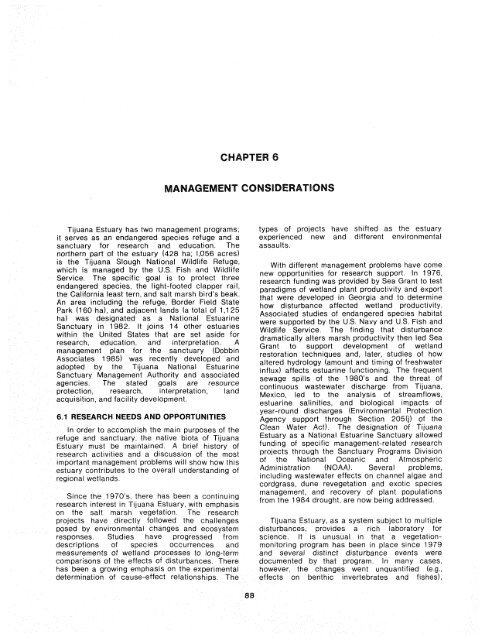The Ecology of Tijuana Estuary, California: An Estuarine Profile
The Ecology of Tijuana Estuary, California: An Estuarine Profile
The Ecology of Tijuana Estuary, California: An Estuarine Profile
You also want an ePaper? Increase the reach of your titles
YUMPU automatically turns print PDFs into web optimized ePapers that Google loves.
CHAPTER 6<br />
MANAGEMENT CONSIDERATIONS<br />
<strong>Tijuana</strong> <strong>Estuary</strong> has two management programs; types <strong>of</strong> projects have shifted as the estuary<br />
it serves as an endangered species refuge and a experienced new and different environmental<br />
sanctuary for research and education. <strong>The</strong> assaults<br />
northern part <strong>of</strong> the estuary (428 ha; 1,056 acres)<br />
is the <strong>Tijuana</strong> Slough National Wildlife Refuge,<br />
With different management problems have come<br />
which is managed by the U.S. Fish and Wildlife<br />
new opportunities for research support. In 1976,<br />
Service. <strong>The</strong> speciflc goal is to protect three<br />
research funding was provided by Sea Grant to test<br />
endangered species, the light-footed clapper rail,<br />
paradigms <strong>of</strong> wetland plant productivity and export<br />
the <strong>California</strong> least tern, and salt marsh bird's beak.<br />
that were developed in Georgia and to determine<br />
<strong>An</strong> area including the refuge, Border Field State<br />
how disturbance affected wetland productivity.<br />
Park (160 ha), and adjacent lands (a total <strong>of</strong> 1 ,I 25<br />
Associated studies <strong>of</strong> endangered species habitat<br />
ha) was designated as a National <strong>Estuarine</strong><br />
were supported by the U.S. Navy and U.S. Fish and<br />
Sanctuary in 1982. It joins 14 other estuaries<br />
Wildlife Service. <strong>The</strong> finding that disturbance<br />
within the United States that are set aside for<br />
dramatically alters marsh productivity then led Sea<br />
research, education, and interpretation. A<br />
Grant to support development <strong>of</strong> wetland<br />
management plan for the sanctuary (Dobbin<br />
restoration techniques and, later, studies <strong>of</strong> how<br />
Associates 1985) was recently developed and<br />
altered hydrology (amount and timing <strong>of</strong> freshwater<br />
adopted by the <strong>Tijuana</strong> National <strong>Estuarine</strong><br />
influx) affects estuarine functioning. <strong>The</strong> frequent<br />
Sanctuary Management Authority and associated<br />
sewage spills <strong>of</strong> the 1980's and the threat <strong>of</strong><br />
agencces. <strong>The</strong> slated goals are resource<br />
continuous wastewater discharge from <strong>Tijuana</strong>,<br />
protection, research, interpretation, land<br />
Mexico, led to the analysis <strong>of</strong> streamflows,<br />
acquisition, and facility development<br />
estuarine salinities, and bioloaical impacts <strong>of</strong><br />
year-round discharges (~nvironhental Protection<br />
6.1 RESEARCH NEEDS AND OPPORTUNITIES Agency support through Section 205(j) <strong>of</strong> the<br />
In order to accomplish the matn purposes <strong>of</strong> the ciean Water Act) <strong>The</strong> deslgnatton Ti~uana<br />
refuge and sanctuary, the nat~ve biota <strong>of</strong> <strong>Tijuana</strong> <strong>Estuary</strong> as a National <strong>Estuarine</strong> Sanctuary allowed<br />
<strong>Estuary</strong> must be A brief history <strong>of</strong> funding <strong>of</strong> specific management-related research<br />
research actrvftles and a discussion <strong>of</strong> the most projects through the Sanctuary programs ~ivis~on<br />
~mportant management problems wtll show how this Of the Nat'onal Oceanic and AtmOspher'c<br />
estuary contributes to the overall understanding <strong>of</strong> Admintstration Several problems+<br />
regional wetlands<br />
including wastewater effects on channel algae and<br />
Since the 19703, there has been a continuing<br />
research interest in <strong>Tijuana</strong> <strong>Estuary</strong>, with emphasis<br />
on the salt marsh vegetation <strong>The</strong> research<br />
projects have directly followed the challenges<br />
posed by environmental changes and ecosystem<br />
responses. Studies have progressed from<br />
descriptions <strong>of</strong> species occurrences and<br />
measurements <strong>of</strong> wetland processes to long-term<br />
comparisons <strong>of</strong> the effects <strong>of</strong> disturbances <strong>The</strong>re<br />
has been a growing emphasis on the experimental<br />
determination <strong>of</strong> cause-effect relationships. <strong>The</strong><br />
cordgrass, dune revegetation and exotic species<br />
management, and recovery <strong>of</strong> plant populations<br />
from the 1984 drought, are now being addressed.<br />
<strong>Tijuana</strong> <strong>Estuary</strong>, as a system subject to multiple<br />
disturbances, provides a rich laboratory for<br />
science. It is unusual In that a vegetationmonitoring<br />
program has been in place since 1979<br />
and several drstinct disturbance events were<br />
documented by that program. In many cases,<br />
however, the changes went unquantified (e.g.,<br />
effects on benth~c invertebrates and fishes),

















